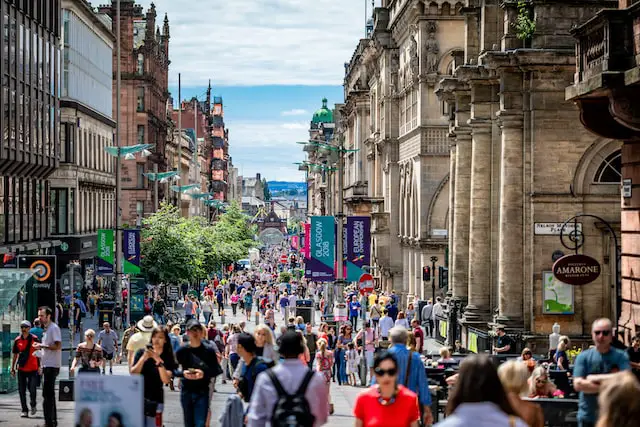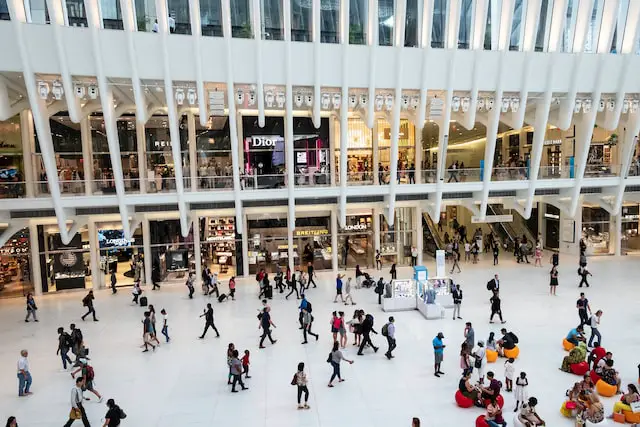2022 has reshaped the real estate market and especially retail properties. But what will be the major retail property market trends in 2023?
One sector that has been hit significantly by the global pandemic in the last few years is the retail property market. New consumer buying behaviours and changes in the global supply chain have resulted in rethinking by retailers, investors and development companies. But also other events have increased this change, including conflicts, climate change, and various new regulations.
Not all types of retail have been affected equally and there are some that might outperform others significantly. in the following article, we will provide you with 5 retail property market trends in 2023 that you should be familiar with.
5 Key Retail Property Market Trends in 2023
- High-Street Retail in the Long-Term
- Retail Redevelopments
- Innovative Store Concepts
- Grocery Store Transformation
- Importance of ESG

What Happened in 2022?
The last year has been a year of transformation. The major impact of the Covid-19 pandemic has been seen and retailers as well as real estate companies started to implement new strategies to counter these effects. Knightfrank has called it the year of the “Re-”, which stands for rebuilding, resolving, reengineering, and more.
These changes are necessary due to numerous trends in 2022. For instance, the increasing share of e-commerce sales. Online orders have grown significantly while in-store purchases have not recovered to levels before the pandemic. As a consequence, many retailers must adapt their sales strategy and use multiple channels to sell their products. Furthermore, consumer preferences have changed. A significant decline in the fashion industry has been noticed, while household products have increased in demand. As a result, the most demanded types of retail real estate in 2022 were retail parks and retail warehouses.
But not only the retail market itself has changed, there are also a number of new global challenges that affect businesses and consumers. These include high inflation, supply chain problems due to conflicts and climate change, and an overall decline in the economy. This puts a lot of pressure on households and retailers, as spending declines and costs increase.
The 5 Retail Property Market Trends in 2023
As you can see, 2022 has changed a lot in the retail property sector and with new challenges, the upcoming year will require even more rethinking. The following trends can give you an outlook into what might shape the market in 2023.
1 | High-Street Retail in the Long-Term
While high-street retail properties have seen notable losses following the pandemic, their good location and low management requirements can be a significant advantage in the long term. A recovery in high-street rents has been noticed in some locations and it can be anticipated that this increase will continue over the upcoming months.
Another reason for the potential in high street retail is that these types of properties are often not complying with new ESG regulations and therefore can possibly be purchased at a discount over other assets in this area.
2 | Retail Redevelopments
Another retail property market trend in 2023 is the redevelopment of existing space. This change is relevant for lower-grade properties such as class-B and class-C stores as well as shopping centres. It has been tried to revitalize such properties through new incentives and experiences for visitors, but in some cases, a redevelopment might be the better solution.
By converting retail stores into offices, residential or leisure properties, new use cases can be found with a better return. Additionally, these conversions also attract customers to still-existing stores in the shopping centre.

3 | Innovative Store Concepts
To attract customers back to actual shops and increase in-store sales, companies must find innovative store concepts that differentiate them from their competition. With the high share of e-commerce purchases, it is essential to understand the buying behaviour within physical retail spaces.
Using modern technologies, such as sensors and AI, can provide the needed advantage and increase the amount of data to work with. Some examples of these new concepts include 100% automated stores, personalised experiences using facial recognition and social media, as well as bringing the benefits of online shopping to retail stores (customer reviews, comparing products, …). The collected data from transactions can be used to further enhance the buying experience. Retail stores in Asia-Pacific were able to increase customer engagement by up to 19% after implementing AI technology.
4 | Grocery Store Transformation
With the increase in demand for household goods and a continuous need for food and beverages, grocery stores will be a priority for 2023. However, even this type of retail property is going through a major transformation. An increasing number of people are buying groceries online, resulting in a CAGR for this market of 25.3% from 2022 to 2030.
Supermarket chains have observed this trend and are more frequently also offering a service to deliver their products within minutes to local customers. Due to their ideal location throughout cities and suburbs, they can easily adapt to this change.
5 | Importance of ESG
ESG regulations will continue to become more important but also more severe. This leads to many outdated retail properties and even entire portfolios that are not sufficiently prepared for the future in terms of sustainability. For the UK alone this means that about 90% of the current building stock will have to be improved by 2030 with energy-efficient measures.
With increasing construction costs and supply chain issues, new strategies must be developed to counter these effects. Furthermore, more transparency of ESG solutions and more knowledge about the topic has to be available, so that stakeholders are able to make informed decisions. For example, one common misconception is that green buildings are much more expensive than standard ones. Refurbishment or construction costs are only slightly higher but operating expenses can be reduced significantly.
Conclusion
With significant challenges in 2022, the upcoming year will also not be easy for real estate investors and companies. But 5 retail property market trends in 2023 are going to be the most impactful. High-street stores are likely to perform well and provide a stable return for a relatively low risk. On the other hand, larger class-b and -c shopping centres are going to be redeveloped into mixed-use properties to find a new use and attract more customers. Technology will impact retail stores and also help supermarkets to create an omnichannel strategy with local delivery options. Lastly, ESG is getting more important and the real estate industry needs to act now in order to protect their properties from new regulations and significant price discounts.
If you want to learn more about the future of commercial real estate, including topics such as sustainability & ESG, PropTech, architecture, development and investment, feel free to take a look at our other articles on Smart CRE. Here you will also find insights into the job market and how to start a career in real estate.
To stay up-to-date, we would be very happy if you subscribe to our monthly newsletter. Just enter your e-mail address below. Thank you!

